B2B Tech Marketing: Benefits, Strategies & Challenges [2024]
Effective marketing is a must for B2B tech businesses because your success not only depends on the quality of your products/services but also on how you promote them. However, many businesses are not aware of the impact of marketing for their success. More than half of businesses in the US allocate less than 5% of their budgets to marketing (see Figure 1 below).
Figure 1. Share of budgets allocated to marketing according to B2B companies in the United States in 2020
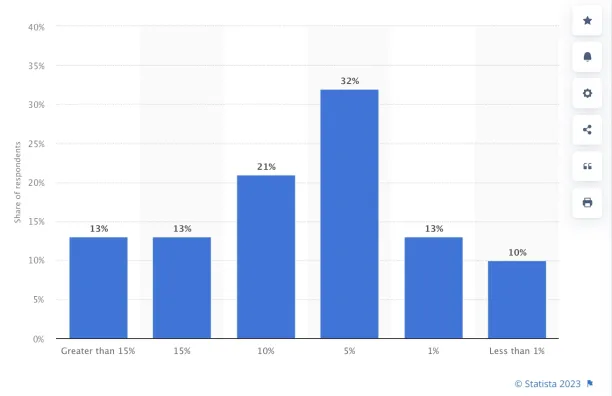
Source: Statista
In this article, to introduce the importance of B2B tech marketing, we will explain its types, best practices and challenges.
What is B2B tech marketing?
B2B (business-to-business) tech marketing refers to marketing promoting technology solutions or services to businesses. This can include marketing frameworks such as:
- channel management
- product marketing
- content marketing
- segmentation, targeting, and positioning (STP)
- attention, interest, desire, action (AIDA) model
What are the differences between B2B and B2C marketing?
B2B tech marketing and business-to-consumer (B2C) tech marketing are both types of marketing that focus on promoting technology products or services.
The main difference between B2B and B2C tech marketing is the target audience. B2B tech marketing is directed towards other businesses, while B2C tech marketing is directed towards individual consumers. This leads to some other important differences.
Key differences between the two include:
Marketing tactics
While some tactics such as email marketing, content marketing, and SEO are common in both, social media marketing is different (see Figure 2 for a detailed comparison):
- B2B marketers tend to focus on channels like Linkedin that focus on the professional aspect of a user’s life.
- B2C marketers tend to focus on channels like Facebook and Instagram that focus on individual life and consumption.
Figure 2. Leading social media platforms used by B2B and B2C marketers
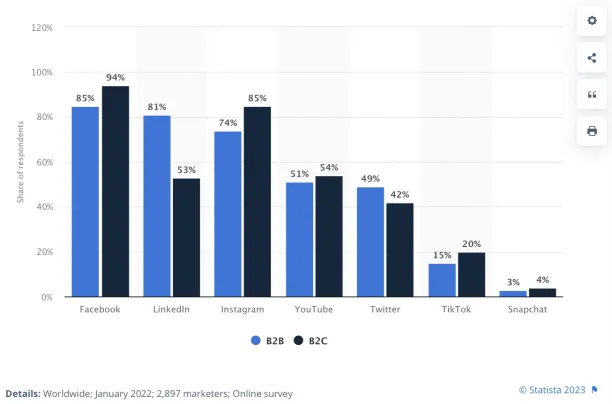
Source: Statista
Channel marketing is completely different:
- In B2B, intermediaries are often other businesses or organizations, such as resellers, distributors, and system integrators like Accenture.
- In B2C, intermediaries are typically retailers, such as department stores and online marketplaces like Walmart.
Decision-making process
In B2B tech marketing, the decision to purchase a technology product or service may involve multiple people and departments within a business, while in B2C tech marketing, the decision is typically made by an individual consumer.
Sales process
B2B tech sales may involve longer sales cycles and more complex negotiations, while B2C tech sales are often more straightforward.
Attribution
Longer sales processes can make it more difficult to attribute the success of a marketing campaign to a specific action or touchpoint in B2B marketing. B2B marketing campaigns usually require a multi-channel approach, and are focused on building relationships and providing education. So attribution models that track long-term engagement and the customer journey, like the data-driven attribution, are commonly used.
In contrast, B2C marketing campaigns are usually focused on driving immediate sales and can be more easily attributed to specific actions or touchpoints. B2C marketing campaigns are typically driven by online or offline promotion and advertising, so attribution models that track immediate conversions, like the last-click attribution, are more common.
Learning loops
The main difference between the B2B and B2C learning loops is the target audience and the level of customer engagement.
- B2B learning loops are usually more focused on specific customer needs and involve a higher level of customer engagement.
- B2C learning loops are more focused on identifying patterns and trends among a large number of customers and involve less direct customer engagement.
Why is B2B tech marketing important for tech companies?
In today’s competitive environment, it is not possible to sell at scale without an effective marketing approach. Marketing is directly measuring reactions of potential customers, closing sales with smaller customers and initiating sales to enterprises.
B2B tech sales started in the 1960s with a sales led model where sales reps contacted customers, closed the sale and earned hefty commissions. Marketing was relegated to the secondary role of creating sales collateral and leveraging PR for awareness campaigns.
With the rise of the internet, performance marketing became a revenue driver for B2B tech companies thanks to its ease of use and measurable results.
With the rise of SaaS, marketing has become even more valuable as companies started to rely on Product Led Growth (PLG).
Some of the current benefits of marketing for B2B tech industry in general include these:
- Businesses can gain access to larger customer pools who are looking for the type of technology that companies provide.
- It helps them to generate leads and drive sales of their technology products or services to other businesses, leading to larger deals and longer-term contracts.
- It helps tech companies to build relationships with other businesses, which can lead to repeat business and referrals.
- It enables tech companies to better understand the needs and pain points of other businesses in their industry, which can inform product development and improve the overall customer experience.
5 types of B2B tech marketing
The PESO model is a framework for understanding the different types of media and how they can be used to communicate with target audiences. The acronym PESO stands for Paid, Earned, Shared, and Owned media:
- Paid media refers to advertising that is purchased, such as television or print ads, sponsored content, and pay-per-click ads.
- Earned media refers to media coverage that is gained through public relations efforts, such as news stories, reviews, and testimonials.
- Shared media refers to content that is created and shared by individuals on social media platforms, such as Facebook, Instagram, and Twitter.
- Owned media refers to the channels that a company or organization controls, such as their website, blog, and email newsletters.
The PESO model is important because it provides a holistic approach to communication and allows companies to create a more effective and efficient strategy by using a combination of different types of media in different marketing strategies and channels.
The PESO model can be implemented in a combination of different strategies such as:
1. Email marketing
Although email marketing may seem outdated due to the popularization of new channels, especially social media, it is still on the rise (see Figure 3). Sending targeted emails to other businesses to promote technology products or services.
Figure 3. Email marketing revenue estimation from worldwide from 2020 to 2027
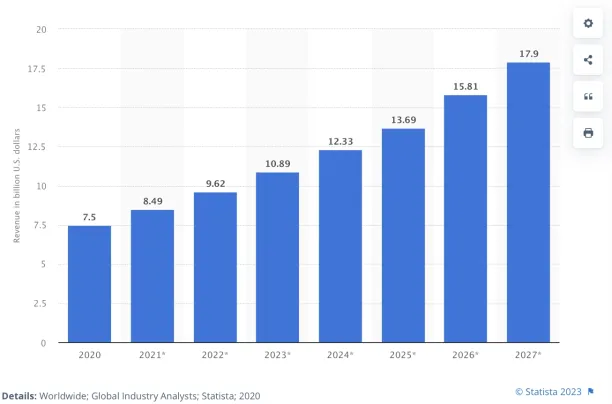
Source: Statista
2. Paid marketing
This involves creating digital ads to target potential customers online. Also it includes optimizing digital platforms such as websites and apps for promotional purposes.
3. Content marketing
Creating and distributing valuable, relevant, consistent and engaging content to attract and retain a clearly defined audience of other businesses. This can include blog posts, articles, case studies, white papers, and more.
4. Social media marketing
Using social media platforms such as Facebook, Instagram and LinkedIn to promote technology products or services to other businesses.
5. Search engine optimization (SEO)
Optimizing a website to rank higher in search engine results pages, to drive more traffic to the site and generate leads. 69% of marketers invest time in SEO, which shows how important it is in marketing.1 SEO is achieved by analyzing keyword rankings, optimizing page titles and URLs for maximum impact, and maintaining high quality content.
Top 10 B2B tech marketing best practices
This depends on your target audience and the maturity of your marketing function. However, some generally correct principles include:
Business-stage based practices
Seed stage
- Identify the Ideal Customer Profile (ICP). In the beginning, vendors sell to the network of their founders. So, marketing is more focused on understanding the market rather than shaping it. Identifying ICP both in terms of firmographics and the profiles of buyers will make it easy to plan your marketing strategy.
- Identify the right channels and messages to reach your ICP. In order to create effective marketing campaigns, it is important for tech companies to quickly:
- Identify the right messages: This includes understanding the needs and pain points of ICP and their jargon so your brand can speak about their problems convincingly.
- Identify the right channels: There are too many channels to focus on and your ICP’s preferred channels can help you focus your marketing efforts
Startup
- Find your best performing channel. Not every channel works for every company and yours. In the startup stage, it is crucial to find the best performing channels for promoting your business to your target audience.
Scaleup
- Scale your partner channel. This can include recruiting new partners, providing training and support to existing partners, and developing new programs and incentives to encourage partners to sell more of the company’s products or services.
- Go multi-channel. Now that you have relatively consolidated a target audience and business environment, it is better to enrich your business channels by going multi-channel. You can include content marketing, email marketing and paid marketing efforts to boost your marketing.
Enterprise
- Implement and strengthen analyst relations. Enterprises can use analyst relations (AR) as a way to increase their technology marketing efforts by building relationships with industry analysts and influencers.
Practices to revisit regardless of the business stage
- Decide the right mix of in-house vs outsourced marketing. Setting up analytics is like a one time project potentially outsourced but tracking metrics regularly should be in-house.
- Use social media effectively. Social media can be a powerful tool for B2B tech marketing, as it allows tech companies to connect with other businesses and share information about their products or services. Tech companies should use social media to:
- Share valuable content
- Engage with their audience
- Build relationships with other businesses
- Optimize your business website for lead generation. Tech companies should optimize their website for lead generation by including calls-to-action, lead capture forms, and other elements that encourage visitors to take action.
- Implement data analytics. Data analytics is a valuable tool for B2B tech marketers, as it helps companies to understand the effectiveness of their marketing efforts and make data-driven decisions. Tech companies should track key metrics such as website traffic and leads generated, and use this data to optimize their marketing efforts.
What are the challenges in B2B tech marketing?
Certain root causes lead to symptoms that lead to inefficient and ineffective B2B marketing:
Root causes
Too many solution categories
There are too many solution categories for any buyer to understand. This confuses buyers and slows down the sales process.
Number of solution categories is increasing because every vendor wants to be a category creator. No one wants to be known as just another brand in a category.
Vendors want to own a new category because this allows them to:
- Differentiate their prices
- Limit the companies that they get compared to during the procurement process
To achieve this, they:
- Pay industry analysts. Industry analysts are not pay-to-pay in the traditional sense. Brands do not get ranked higher just because they pay more. However, paying more allows brands to spend more time with industry analysts giving them a chance to shape their thinking and influence the launching of new categories.
- Pay influencers to influence the ecosystem and create new categories.
- Use their website and social media presence to promote their category.
As a result, the number of tech categories is increasing rapidly (Figure 4).
Figure 4. Number of tech solution categories according to decades
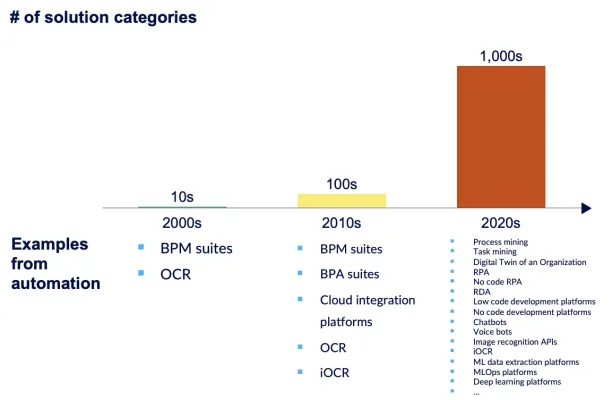
Too many competitors
B2B markets hold some of the largest revenue pools and are therefore highly competitive. Even when vendors can create new categories in the minds of buyers and industry analysts, they soon find that other vendors also claim to have solutions for these new categories.
This makes differentiation in challenging and understanding of the customer’s problem.
Complex products
B2B tech products and solutions tend to be complex and may require technical knowledge to fully understand. This can make it difficult to explain the product or solution to potential customers in a way that is easily understandable and compelling.
Symptoms
Long sales cycles
B2B tech products and solutions often have long sales cycles, which can be challenging for marketers. This is because it may take a long time to educate potential customers about the product and its benefits, and to persuade them to make a purchase.
Expensive but ineffective marketing campaigns
Buyers are bombarded with messages from tens of competing companies and never get a chance to develop an in-depth understanding of the differences between different vendors’ approaches. As a result, most marketing spend turns into campaigns that mostly:
- Are ignored as decision makers need to juggle multiple priorities and do not see the urgency to buy the marketed solutions
- Lead to ineffective meetings as buyers:
- do not trust the vendors
- do not have a sufficient understanding of the category
- can not gain that understanding from vendors since they don’t trust them
Recommendations
B2B tech marketers need to follow the B2B tech marketing best practices, starting with identifying the ICP and building the marketing engine around that definition of the ideal customer to break through the noise and impress B2B tech buyers.
If you have questions about B2B tech marketing or need help, feel free to get in touch:
External Links
- 1. “Not Another State of Marketing Report.” HubSpot, 29 January 2022, https://www.hubspot.com/hubfs/State-of-Marketing%20(2).pdf. Accessed 24 January 2023.

Cem has been the principal analyst at AIMultiple since 2017. AIMultiple informs hundreds of thousands of businesses (as per similarWeb) including 60% of Fortune 500 every month.
Cem's work has been cited by leading global publications including Business Insider, Forbes, Washington Post, global firms like Deloitte, HPE, NGOs like World Economic Forum and supranational organizations like European Commission. You can see more reputable companies and media that referenced AIMultiple.
Throughout his career, Cem served as a tech consultant, tech buyer and tech entrepreneur. He advised businesses on their enterprise software, automation, cloud, AI / ML and other technology related decisions at McKinsey & Company and Altman Solon for more than a decade. He also published a McKinsey report on digitalization.
He led technology strategy and procurement of a telco while reporting to the CEO. He has also led commercial growth of deep tech company Hypatos that reached a 7 digit annual recurring revenue and a 9 digit valuation from 0 within 2 years. Cem's work in Hypatos was covered by leading technology publications like TechCrunch and Business Insider.
Cem regularly speaks at international technology conferences. He graduated from Bogazici University as a computer engineer and holds an MBA from Columbia Business School.
To stay up-to-date on B2B tech & accelerate your enterprise:
Follow on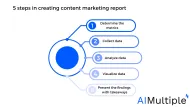
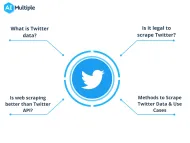
Comments
Your email address will not be published. All fields are required.